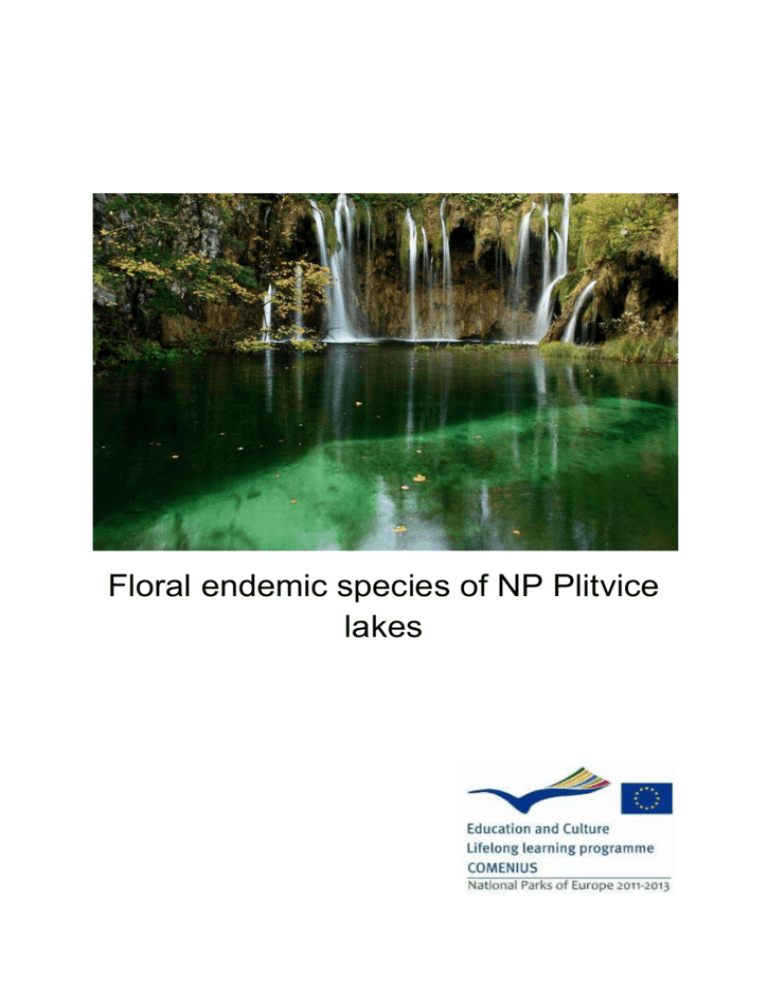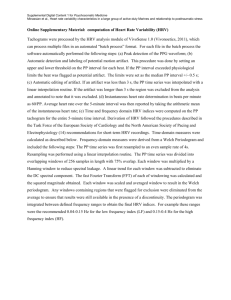Floral endemic species of NP Plitvice lakes Introduction: The Park is
advertisement

Floral endemic species of NP Plitvice lakes Introduction: The Park is situated at 44°51N 15°37E, 44.85°N 15.62°E, in central Croatia, in the eastern part of the mountainous region of Lika-Senj county. The National Park is also home to 4,000 inhabitants. The local economy is based on tourism and farming. Area of Plitvice National Park is 29,617,63 ha, of which 4243.64 ha is meadow, water surface 232.75 ha , and forest 24827.51 ha. Peculiarities of the flora of the park are the result of a number of environmental factors. Among them we can single out geographic location (about 60 km away from the sea) in the hinterland of the longest and highest Croatian mountain of Velebit, the line between coastal and continental rainfall regimes, differences in altitude of 800 m (the highest point Seliški vrh 1289 m and the lowest along the river Korana 470 m ), geological substrate, terrain exposure, circulation of air masses, etc. Endemic species In addition to these endemic species in the flora of the park is still an impressive number of other endemic species, which can be given the their size range classified in three groups: First Croatian endemic and some parts of the Balkans Second some narrow endemic areas of Europe Third endemic areas of wider Europe The first group of endemic species in the park belonging to 28 species, 14 the second and third group of 30 species. From this we can concluded that the flora of the park, you join them, and three species in the vicinity of the park boundaries are the locus classicus, of 75 endemic species. Near the border of NP Plitvice Lakes are three biotopes (locus classicus) endemic species: uskolisno zvonce (Edraianthus tenuifolius), žabnjak kolovrc (Ranunculus scutatus ) and livadni procjepak (Edraianthus tenuifolius). lat. Edraianthus tenuifolius eng. Narrow-leaved bellflower hrv. Uskolisno zvonce Narrow-leaved bellflower is an endemic plant that grows on rocky and sunny meadows of the coast to the upper mountain location. lat. Crepis corylifolia eng. Hawk's-beard hrv. Dimak Crepis,is a genus of about 200 annual and perennial flowering plants of the family Asteraceae superficially resembling the dandelion.The name Crepis derives from Greek, meaning "shoe". lat. Telekia speciosa eng. Heart-leaved ox eye hrv. Oman Perennial plant 20-60 cm high. The leaves along the edge of the whole orserrated, pointed at the top. Grows in moist meadows, near streams andrivers, along the roads and canals. lat. Ligularia sibirica hrv. Zlatna jezičnica Ligularia sibirica is the type species for the genus Ligularia. It is a 0.3-1.3 m tall perennial herbaceous plant, native tofens and damp grassy meadows in Siberia, Central and Eastern Europe. lat. Drosera rotundifolia eng. Sundew hrv. Okruglolisna rosika The leaves of the sundew are arranged in a basal rosette. The narrow, hairy 1.3-5 centimetre long petioles support 4-10 millimetres long laminae. The upper surface of the lamina is densely covered with red glandular hairs that secrete a sticky mucilage. eng. Utricularia lat. Utricularia minor hrv. Mala mješinka Utricularia, is a genus of carnivorous plants consisting of approximately 233 species . They occur in fresh water and wet soil as terrestrial or aquatic species across every continent except Antarctica. lat. Pinguicula vulgarist eng. Common butterwort hrv. Tustica kukcolovka Pinguicula vulgaris is a perennial carnivorous plant . It grows to a height of 3–16 cm, and is topped with a purple, and occasionally white, flower that is 15 mm or longer, and shaped like a funnel. This butterwort grows in damp environs such as bogs and swamps, in low or subalpine elevations. lat. Cladium mariscus eng. Saw-sedge hrv. Ljutak Cladium mariscus is a species of flowering plant in the sedge family. It is native of temperate Europe and Asia where it grows in base-rich boggy areas and lakesides. It can be up to 2.5 metres tall, and has leaves with hard serrated edges. lat. Cypripedium calceolus eng. Lady's slipper hrv. Gospina papučica It is a widespread plant worldwide, found from Europe east through Asia to the Pacific Ocean. It is found in open woodland on moist calcareous soils. It is found in continental Europe growing in the decomposed humus of semi-shaded woodland cover on limestone. lat. Scilla litardierei hrv. Livadni procjepak Bulbous perennial that is climp-forming. Leaves are linear, basal and reach 6 to 12 inches long in early summer. At the same time, racemes of star-shaped, blue to violet flowers bloom. Good for naturalizing.











